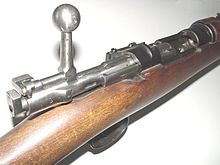Carl Gustaf M / 96
| Carl Gustaf M / 96 | |
|---|---|
| general information | |
| Civil name: | Sweden moult |
| Military designation: | Gevär m / 96 |
| Country of operation: | Sweden |
| Developer / Manufacturer: |
Mauser , Carl Gustafs Stads Gevärsffektori, Husqvarna |
| Development year: | 1894 |
| Manufacturer country: | Sweden |
| Production time: | 1894 (Mauser) to 1944 (Husqvarna) |
| Weapon Category: | gun |
| Furnishing | |
| Overall length: | M / 94: 950 M / 96: 1260 M / 38: 1120 mm |
| Weight: (unloaded) | M / 94: 3.4 M / 96: 3.97 M / 38: 3.8 kg |
| Barrel length : | M / 94: 450 M / 96: 740 M / 38: 610 mm |
| Technical specifications | |
| Caliber : | 6.5 x 55 mm |
| Possible magazine fillings : | 5 cartridges |
| Ammunition supply : | fixed box magazine , loading strip |
| Number of trains : | 4th |
| Twist : | right, 240 mm |
| Visor : | open sights |
| Closure : | Cylinder lock with bolt handle |
| Charging principle: | Repeater |
| Lists on the subject | |
The Carl Gustaf M / 96 was a rifle used by the Swedish armed forces .
history
When smokeless cartridges were introduced worldwide towards the end of the 19th century, the Swedish military also demanded a modern repeating rifle for such powerful ammunition. Until then, guns of the Jarmann M 1884 type with black powder ammunition were part of the equipment. Sweden and Norway, allied in a union at the time , agreed in 1893 on a common standard cartridge with the 6.5 × 55 mm . Sweden ordered a few examples in this caliber from Mauser and after successful testing decided on a license agreement with the German company. Mauser manufactured the first weapons himself in Oberndorf ; From 1901 onwards, production took place exclusively in the country, mainly at Carl Gustafs Stads Gevärsffektori in Eskilstuna . The rifle was officially introduced in 1896 and remained in structural use for more than eight decades, albeit in many different forms.
The last infantry models were not taken out of service until 1978; some sniper rifles were in use well into the 1990s. After the withdrawal, Sweden sold its holdings. In view of their precision and the consistently good workmanship, the reserve weapons were very popular. Unlike other states, Sweden was not forced to streamline the production of its weapons due to its neutrality during World War II and maintained its high manufacturing standards.
technology
Like the German Gewehr 98, the Swedish M / 96 had a cylinder lock of the Mauser system with two locking lugs and a wing safety. However, the Swedish model was cocked when closing, while the German counterparts are cocked when the shutter is opened. The bolt stem stood free, so that the breech only rested on the front locking lugs. From the rather long original model M / 96, the 14 cm shorter version M / 38 was developed in 1938 (around 55,000 M / 96 with a straight chamber stem were converted by Carl Gustafs Stads Gevärsffektori in 1938–40, and Husqvarna built around 88,000 new M from 1942–1944 / 38, which can be recognized by their cranked chamber stem).
variants
- M / 94 carabiner
- M / 96 rifle
- M / 38 rifle
- Rifle M / 41 (sniper rifle with telescopic sight Ajack M / 41, AGA M / 42 or AGA M / 43)
- Competition precision rifle with M / 63 rear sight
- Competition precision rifle with M / 80 rear sight
literature
- Sebastien Thiem: Swedish Innovations. Side guns M / 1896, M / 1914 and M / 1915 . In: DWJ (formerly: Deutsches Waffen-Journal) . No. 8 . Journal-Verlag Schwend, 2014, p. 90-95 .
- Carsten Schinke: The light Swedish infantry rifles - army and home defense . Schwäbisch Hall 1990.
Web links
- www.schwedenmauser.de German site with extensive information
- chuckhawks.com: The 1896 Swedish Mauser (English)
- northcapepubs.com: The Swedish Mauser Rifles (English)





